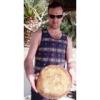
Two Similar, Yet Contrasting Formulae Using An Element of Dark Rye Flour
These are 2 batches of bread made in College on Thursday of this week. I have 6 students entered for a bread competition for Young Baker of the Year, with Warburtons. Their entries are as follows:
- Nettle Bread - has some elements in common with the formula posted by Karin a few months back. See: http://www.thefreshloaf.com/node/18284/vinschgauer-bread-unique-alpine-flavor Includes cumin and coriander spices, plus a wheat levain as a pre-ferment
- Raisin, Shallot and Hazelnut Bread - based on an idea from Richard Bertinet, this bread has a Biga Naturale, appropriate since the baker concerned is originally from Sicily. The shallots are reduced in oil, with a touch of balsamic vinegar and moscavado sugar and the hazelnuts are toasted and nibbed. Flour blend is 25% wholewheat and 75% strong white in total.
- Pumpernickel - a determined effort to perfect a large Pumpernickel loaf [Black Bread] steamed for 16 hours in a Pullman Pan.
- Seaweed and Lemon Bread - thanks Daisy_A, Jan Hedh and Richard Bertinet. The seaweed is wakame, which is soaked overnight. The dough has a pre-ferment with 75% hydration and white flour. The final dough has semolina and wholewheat flour added at 12.5% each, rest of flour total 75%, including the pre-ferment. Lemon zest to bring out the seaweed flavour. The wakame is cut into the mixed dough using a Scotch Cutter; quite a delicate operation. The loaf is shaped as a half lemon, and dusted with semolina to bring out an authentic colour
- "Breakfast Bread" - using a wheat levain, the final dough contains fruit and nut museli, chopped dates and honey
- Flaxseed Bread raised with a Barm - the barm is made from a dry stout from a local traditional brewer. The base for the recipe is Hamelman's flaxseed bread, and Dan Lepard's Barm bread praised by Shiao-Ping and Daisy_A.
I fervently hope all six students will go far. The regional heat is on 15th October; prize being £250. A National Bake-off is held in November, with a winning prize of £1000 plus an "apprenticeship" with Warburtons.
A rarity for me; 3 students in the bakery to practice; no other teaching commitments! So I did some baking experiments of my own at the same time. Here they are:
1. Pain de Campagne [Wheat Levain]
Material Formula [% of flour] Recipe [grams] 1. Wheat Leaven Carrs Special CC White Flour 31.3 940 Water 18.7 561 TOTAL 50 1501 2. Final Dough Leaven [from above] 50 1501 Carrs Special CC White Flour 60 1800 Shipton Dark Rye Flour 8.7 261 Salt 1.8 54 Water 46.7 1400 TOTAL 167.2 5016
Overall Hydration: 65.4%. Pre-fermented Flour 31.3%
Method:
- The leaven has been built over 2 days from stock, as it was needed for student production as well.
- The dough was mixed in a 10 quart Spiral Mixer for 15 minutes. The machine has single speed and bowl direction, and the mix is wonderfully gentle. I find it important to add the water first, then flour and salt, and finally the leaven. I was very happy with the mixed dough quality; dough temperature 26°C.
- Bulk proof, covered, ambient for 1 hour
- Scale 5 loaves at 1kg each, and mould round. Place upside down in prepared bannetons. At this point I will confess that my bannetons often seem to stick, and I have to learn to use a combination of coarse semolina and dark rye flour to prevent this from happening. In the past I've used different flours for dust to differentiate loaves produced. I've now seen too many loaves spoilt to continue this practice!
- I proved these loaves for around 3 to 3½ hours in a prover with gentle humidity, at around 30°C.
After tipping onto the peel and cutting, they were baked in my lovely deck oven on the sole, using steam. Top heat was set at 6.5 and the bottom at 5, with the temperature pre-heated to a solid 240°C. After 15 minutes I turned the heat down to 220°C. I opened the damper after a further 10 minutes and baked out a further 5 minutes before unloading and cooling on wires.
2. Pain de Siègle [Rye Sourdough]
|
Material |
Formula [% of flour] |
Recipe [grams] |
|
1. Rye Sourdough |
|
|
|
Shipton Dark Rye Flour |
20 |
600 |
|
Water |
20 |
600 |
|
TOTAL |
40 |
1200 |
|
|
|
|
|
2. Final Dough |
|
|
|
Rye Sourdough [from above] |
40 |
1200 |
|
Carrs Special CC White Flour |
80 |
2400 |
|
Salt |
1.8 |
54 |
|
Water |
46.7 |
1400 |
|
TOTAL |
168.5 |
5054 |
Overall Hydration: 66.7%. Pre-fermented Flour: 20%
Method:
- Stock sourdough had been built over 2 days as for the first dough
- The dough was mixed in a 10 quart upright mixer. Mixing times were 2 minutes on first speed and 6 minutes on third speed. Final dough temperature was 26°C.
- Bulk proof as above, 1 hour.
- Scale 3 loaves at 1kg and 4 at just over 500g. Mould round and place upside down in bannetons prepared with dark rye flour.
- Proof as above for just under 3 hours.
- Bake to the same profile given above.
Notes:
- The rye sourdough ferments quicker, even though the amount of pre-fermented flour is lower. The stiff levain is so much mellower than the rye. All down to ash content and water levels, methinks!
- These are unashamedly commercial recipes. I am so pleased with the end resulting breads. Great feedback from all the staff too; not always forthcoming from those with such expertise over various areas of food and hospitality!
Photos below:
All good wishes
Andy

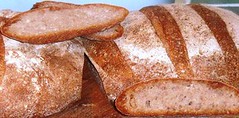

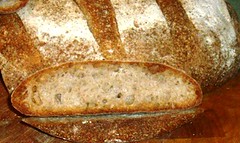

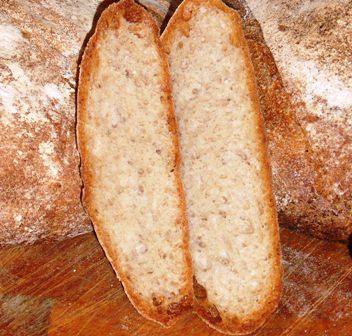
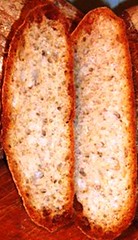
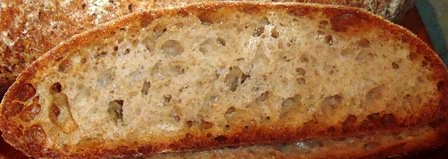


Comments
Nothing 'commercial' to my mind with breads that are wholly levain based. And certainly more flavor I have to believe than what the usual commercial breads yield.
You are certainly right about rye sourdoughs maturing more rapidly. I've discovered mine has not only a voracious appetite, but an amazing ability to ferment anywhere from 3 - 4 hours faster than my while dough levain if I mix up both at the same time.
I'm guessing the small percentage of rye in your pain de campagne added a nice bit of complexity to the overall flavor.
Nice bakes!
Larry
Many thanks Larry,
I said experimentation, for sure. But, given a bakery, some fine flour and access to 2 kicking leavens, I'm realising it was scarcely experimental, in many ways.
The truth is in the eating actually. Tomorrow's sandwiches, then!
But, yes: the rye sour at only 20% of the flour fermented quicker than the wheat at over 30%.
I live and work in the hope that these are the sorts of bread we will regularly see offered up as commercial fayre in the not too distant future...quite a challenge!
Nonetheless, I love the simplicity and balance in both formulae.
I see Daisy's pointing you to Borodinsky...go on, you know you want to!
Best wishes
Andy
I am especially interested in the rye bread. Haven't stopped my chase for the ideal sourdough rye yet. Good luck to those students!
Keep up that chase txfarmer,
Larry seems to be setting the pace just now!
BW
Andy
Wonderful looking loaves Andy!
While even though you say it's a commercial recipe, I haven't seen many commercial loaves looking quite as fine as yours. I'm sure your students will do well in the competition with your expertise to guide them. Great work Andy!
Franko
Many thanks Franko.
Actually my students will do well if they are shortlisted. So, I just hope those judging are pulled in by the recipes and formulae sent in, along with photographs. There products are all just about spot-on; merely fine tuning from here.
As regards commercial recipes, I really cannot add a lot to what Daisy says below. I've turned out loaves such as these by the 000 on a weekly basis. It can be done, with the expertise Daisy references. The other key factor is the same one you likely come up with day in day out....oven capacity! Am I right?
Thanks again, and thanks Daisy; your note below is spot on!
Andy
Hi Andy,
Daisy makes a very astute observation that I completely missed in regards to 'commercial breads' and your formulae being accessible to smaller shops and production schedules.
Much as I'd love to make this bread at our shop, it's about 2hrs outside of our current production envelope...and probably always will be. It's a shame really because it's entirely do-able if our head office were to decide it should be so, and budgeted accordingly. If our current sales of the fake artisan style breads are any indication, there's definitely a consumer demand for this class of bread. Little doubt in my mind as to how our customers would react to actually being able to pick up a loaf of the real thing while shopping at our store, instead of what we offer now.
As for oven space...is there ever really enough? We have 3 rack ovens capable of baking 320 pan loaves or 90+ hearth style simultaneously and I still wind up having periods of production time where I have a lineup (although brief) of product waiting to go into the oven.
Franko
Hi Andy, both very nice breads, but this time around I'm a bit undecided: better the pinkish color of one loaf or the very regular crumb or the other? In the doubt, may I have a slice of both? ;-)
Maybe you forgot to add the rye starter percentage in the sourdough build of the Pain de Siègle? Or did you just let ferment rye flour and water for 2 days without starter?
Nico
Hi Nico,
If you look at the bottom 3 rows of photos from the top down, they are as follows:
top left is Pain de Siegle, top right is Pain de Campagne
middle are both Pain de Campagne
bottom is Pain de Siegle.
I used a number of different settings on the camera, hence the different lighting.
As regards the leaven formula, I just gave an overall amount for flour and water in the built leavens. Because I needed a large quantity for the students' work, and I wanted it to be active, I made sure both rye and wheat leavens were well-fed over a 2 day period. So the build is not shown, but the proportions of flour and water in the built leavens remain accurate. Hope this clarifies.
Pain de Siegle has just a gentle tang from the rye sour. For a leaven at over 30%, the Pain de Campagne is very subtle indeed, and equally delicious. So yes, I'd recommend a slice of both
Best wishes
Andy